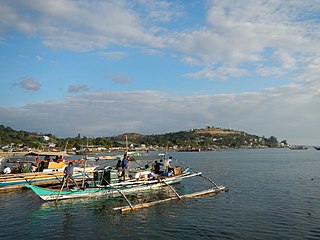
Zambales, officially the Province of Zambales, is a province in the Philippines located in the Central Luzon region. Its capital is Iba, which is located in the middle of the province. Zambales borders Pangasinan to the north and northeast, Tarlac to the east, Pampanga to the southeast, Bataan to the south and the South China Sea to the west. With a total land area of 3,830.83 square kilometres (1,479.09 sq mi), Zambales is the second largest among the seven provinces of Central Luzon after Nueva Ecija. The province is noted for its mangoes, which are abundant from January to April.

Ramon del Fierro Magsaysay was a Filipino statesman who served as the seventh President of the Philippines, from December 30, 1953, until his death in an aircraft disaster on March 17, 1957. An automobile mechanic by profession, Magsaysay was appointed military governor of Zambales after his outstanding service as a guerrilla leader during the Pacific War. He then served two terms as Liberal Party congressman for Zambales's at-large district before being appointed Secretary of National Defense by President Elpidio Quirino. He was elected president under the banner of the Nacionalista Party. He was the youngest to be elected as president, and second youngest to be president. He was the first Philippine president born in the 20th century and the first to be born after the Spanish colonial era.

Iba, officially the Municipality of Iba, is a 1st class municipality and capital of the province of Zambales, Philippines. According to the 2020 census, it has a population of 55,581 people.

Castillejos, officially the Municipality of Castillejos, is a 3rd class municipality in the province of Zambales, Philippines. According to the 2020 census, it has a population of 67,889 people.

San Marcelino, officially the Municipality of San Marcelino, is a 1st class municipality in the province of Zambales, Philippines. According to the 2020 census, it has a population of 37,719 people.

Santa Cruz, officially the Municipality of Santa Cruz, is a 1st class municipality in the province of Zambales, Philippines. According to the 2020 census, it has a population of 63,839 people.

Subic, officially the Municipality of Subic, is a 1st class municipality in the province of Zambales, Philippines. According to the 2020 census, it has a population of 111,912 people.

The Sambal people are a Filipino ethnolinguistic group living primarily in the province of Zambales and the Pangasinense municipalities of Bolinao, Anda, and Infanta. The term may also refer to the general inhabitants of Zambales. They were also referred to as the Zambales during the Spanish colonial era.
The legislative districts of Zambales are the representations of the province of Zambales and the highly urbanized city of Olongapo in the various national legislatures of the Philippines. The province and the city are currently represented in the lower house of the Congress of the Philippines through their first and second congressional districts.
The Sambalic languages are a part of the Central Luzon language family spoken by the Sambals, an ethnolinguistic group on the western coastal areas of Central Luzon and the Zambales mountain ranges.

Castillejos National High School is a school located in Castillejos, Zambales, Philippines. It provides education from Grade 7 to 12. Beside the school was the Villafor Elementary School. The school has different clubs that student can join in.

Established in 2000, Manila Business College is duly accredited by the Commission on Higher Education of the Philippines and the Technical Education and Skills Development Authority (TESDA). It provides an international standard of business education that combines Asian and Western concept of business management and economics studies.
Antonio Magsaysay Diaz was a politician and lawyer. He was elected to the House of Representatives of the Philippines representing Zambales for three separate tenures – 1969 to 1972, 1992 to 2001, and 2004 until his death on August 3, 2011.

Local elections were held in Zambales on May 13, 2013, as part of the 2013 general election. Voters selected candidates for all local positions: a town mayor, vice mayor and town councilors, as well as members of the Sangguniang Panlalawigan, the vice-governor, governor and representatives for the Two districts of Zambales.

Zambales National High School is a Public school in Iba, Zambales, Philippines. It is one of the oldest secondary schools in the Philippines.

The Zambales local elections was held on May 9, 2016 as part of the 2016 general election. Voters will select candidates for all local positions: a town mayor, vice mayor and town councilors, as well as members of the Sangguniang Panlalawigan, the vice-governor, governor and representatives for the two districts of Zambales.

Sulong Zambales Party is the ruling political party in Zambales, Philippines, founded by incumbent Zambales Governor Hermogenes Ebdane in 2012.

The Dinamulag Festival also known as the Zambales Mango Festival is an annual festival held in the province of Zambales in the Philippines to celebrate or encourage bountiful harvest of the province's mangoes. The festival was first held in 1999. The mascot is a mango.

The Zambales local elections was held on May 13, 2019, as part of the 2019 general election. Voters will select candidates for all local positions: a town mayor, vice mayor and town councilors, as well as members of the Sangguniang Panlalawigan, the vice-governor, governor and representatives for the two districts of Zambales. Incumbent Governor Amor Deloso and Vice Governor Angel Magsaysay-Cheng are seeking re-election for their second term.

The Zambales local election was held on May 9, 2022 as part of the 2022 general election. Voters will select candidates for all local positions: a town mayor, vice mayor and town councilors, as well as members of the Sangguniang Panlalawigan, the vice-governor, governor and representatives for the two districts of Zambales.
























